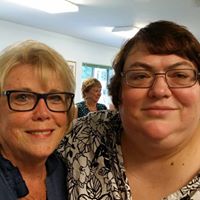Michelle D Leclerc
age ~66
from Manchester, NH
- Also known as:
-
- Michelle D Stanzler
- Michelle Leclerc Stanzler
- Michelle L Stanzler
- Michelle D Landy
- Michelle D Lecler
- Phone and address:
- 50 Laurel St, Manchester, NH 03102
Michelle Leclerc Phones & Addresses
- 50 Laurel St, Manchester, NH 03102
- Goffstown, NH
- Roslindale, MA
- Somerville, MA
- Framingham, MA
Work
-
Company:Signature medical group2009
-
Position:Phlebotomist and processors
Education
-
School / High School:Massasiot College- Canton, MA1993
-
Specialities:Certificate in all areas of phlebotomy
Us Patents
-
Surgical Retractors
view source -
US Patent:20190335990, Nov 7, 2019
-
Filed:Jul 19, 2019
-
Appl. No.:16/517536
-
Inventors:- Raynham MA, US
Nicholas Pavento - North Attleboro MA, US
Sean P. Selover - Westport MA, US
Michelle LeClerc - Middleboro MA, US -
International Classification:A61B 1/32
A61B 5/01
A61B 5/145
A61B 17/02
A61B 90/00
A61B 5/00
A61B 1/07
A61B 1/06
A61B 5/04 -
Abstract:The present disclosure relates to methods and devices for surgically manipulating tissue. In general, the methods and devices can include an elongate retractor shaft having a distal retractor tip that is configured to manipulate tissue, for example the tip can be configured to separate muscle and nerve fibers surrounding a vertebra. The elongate retractor shaft can include an illumination source such that at least a portion of the surgical field is illuminated by the device when the device is used in the body. A sensor can also or alternatively be included on the elongate retractor shaft, for example on the blunt retraction tip, such that the sensor can monitor physiological parameters of the tissue in or adjacent to the surgical field.
-
Surgical Retractors
view source -
US Patent:20150313456, Nov 5, 2015
-
Filed:Jul 13, 2015
-
Appl. No.:14/797717
-
Inventors:- Raynham MA, US
Nicholas Pavento - North Attleboro MA, US
Sean P. Selover - Westport MA, US
Michelle LeClerc - Raynham MA, US -
International Classification:A61B 1/32
A61B 17/02
A61B 1/06
A61B 5/00
A61B 19/00
A61B 5/145
A61B 5/04
A61B 1/07
A61B 5/01 -
Abstract:The present disclosure relates to methods and devices for surgically manipulating tissue. In general, the methods and devices can include an elongate retractor shaft having a distal retractor tip that is configured to manipulate tissue, for example the tip can be configured to separate muscle and nerve fibers surrounding a vertebra. The elongate retractor shaft can include an illumination source such that at least a portion of the surgical field is illuminated by the device when the device is used in the body. A sensor can also or alternatively be included on the elongate retractor shaft, for example on the blunt retraction tip, such that the sensor can monitor physiological parameters of the tissue in or adjacent to the surgical field.
-
Systems And Methods For Surgical And Interventional Planning, Support, Post-Operative Follow-Up, And, Functional Recovery Tracking
view source -
US Patent:20150282796, Oct 8, 2015
-
Filed:Jun 9, 2015
-
Appl. No.:14/734359
-
Inventors:- Raynham MA, US
Michael Gorhan - Raynham MA, US
William J. Frasier - New Bedford MA, US
Cody Cranson - Raynham MA, US
Hassan Serhan - Raynham MA, US
Michael O'Neil - Raynham MA, US
Matthew Parsons - Dartmouth MA, US
Jennifer DiPietro - North Easton MA, US
Christopher Nordstrom - Boston MA, US
John Griffin - Raynham MA, US
Sean Selover - Raynham MA, US
Jonathan Bellas - Raynham MA, US
Michelle LeClerc - Raynham MA, US -
International Classification:A61B 17/02
A61B 17/50
A61B 5/00
G06F 19/00
A61B 19/00 -
Abstract:Various systems and methods are provided for surgical and interventional planning, support, post-operative follow-up, and functional recovery tracking. In general, a patient can be tracked throughout medical treatment including through initial onset of symptoms, diagnosis, non-surgical treatment, surgical treatment, and recovery from the surgical treatment. In one embodiment, a patient and one or more medical professionals involved with treating the patient can electronically access a comprehensive treatment planning, support, and review system. The system can provide recommendations regarding diagnosis, non-surgical treatment, surgical treatment, and recovery from the surgical treatment based on data gathered from the patient and the medical professional(s). The system can manage the tracking of multiple patients, thereby allowing for data comparison between similar aspects of medical treatments and for learning over time through continual data gathering, analysis, and assimilation to decision-making algorithms.
-
Systems And Methods For Surgical And Interventional Planning, Support, Post-Operative Follow-Up, And, Functional Recovery Tracking
view source -
US Patent:20140088990, Mar 27, 2014
-
Filed:Sep 19, 2013
-
Appl. No.:14/031761
-
Inventors:- Raynham MA, US
Max Reinhardt - Wellesley MA, US
Jonathan Bellas - Bridgewater MA, US
Cody Cranson - Middleboro MA, US
Jennifer DiPietro - North Easton MA, US
Mary L. Fowler - Bexley OH, US
William J. Frasier - New Bedford MA, US
John P. Griffin - Boston MA, US
Mark T. Hall - Bridgewater MA, US
David D. Konieczynski - Needham MA, US
Michelle LeClerc - Middleboro MA, US
Thomas Martin - Riverside RI, US
Christopher Nordstrom - Boston MA, US
Michael O'Neil - Mansfield MA, US
James Paiva - Warren RI, US
Matthew Parsons - Dartmouth MA, US
Nicholas Pavento - North Attleboro MA, US
Douglas Raymond - Bridgewater MA, US
James J. Roveda - North Attleboro MA, US
Sean P. Selover - Westport MA, US
Hassan A. Serhan - South Easton MA, US
Michael A. Slivka - Taunton MA, US
Robert E. Sommerich - Norton MA, US -
International Classification:G06F 19/00
A61B 17/02
A61B 6/00
A61B 5/00
A61B 19/00 -
US Classification:705 2, 600202
-
Abstract:Various systems and methods are provided for surgical and interventional planning, support, post-operative follow-up, and functional recovery tracking. In general, a patient can be tracked throughout medical treatment including through initial onset of symptoms, diagnosis, non-surgical treatment, surgical treatment, and recovery from the surgical treatment. In one embodiment, a patient and one or more medical professionals involved with treating the patient can electronically access a comprehensive treatment planning, support, and review system. The system can provide recommendations regarding diagnosis, non-surgical treatment, surgical treatment, and recovery from the surgical treatment based on data gathered from the patient and the medical professional(s). The system can manage the tracking of multiple patients, thereby allowing for data comparison between similar aspects of medical treatments and for learning over time through continual data gathering, analysis, and assimilation to decision-making algorithms.
Resumes

Michelle Leclerc
view source
Michelle Leclerc
view source
Michelle Leclerc
view source
Michelle Leclerc
view sourceLocation:
United States

Michelle Leclerc
view source
Michelle Leclerc Raynham, MA
view sourceWork:
Signature Medical Group
2009 to 2000
Phlebotomist and Processors Morton Hospital
Taunton, MA
1993 to 2003
Phlebotomist Goddard Medical
Brockton, MA
1993 to 1995
Phlebotomist
2009 to 2000
Phlebotomist and Processors Morton Hospital
Taunton, MA
1993 to 2003
Phlebotomist Goddard Medical
Brockton, MA
1993 to 1995
Phlebotomist
Education:
Massasiot College
Canton, MA
1993
Certificate in all areas of phlebotomy Coyle and Cassidy High School
Taunton, MA
1984
High School Diploma
Canton, MA
1993
Certificate in all areas of phlebotomy Coyle and Cassidy High School
Taunton, MA
1984
High School Diploma
Medicine Doctors

Michelle D. Leclerc
view sourceSpecialties:
Internal Medicine - Geriatrics
Work:
Dartmouth-Hitchcock Clinic
2300 Southwood Dr, Nashua, NH 03063
(603)5774000 (phone), (603)5774296 (fax)
2300 Southwood Dr, Nashua, NH 03063
(603)5774000 (phone), (603)5774296 (fax)
Languages:
English
Spanish
Spanish
Description:
Ms. LeClerc works in Nashua, NH and specializes in Internal Medicine - Geriatrics.
Name / Title
Company / Classification
Phones & Addresses
Owner
Leclerc Needle
Pleating/Stitching Services
Pleating/Stitching Services
781 Pne St, Raynham, MA 02767
(508)8241002
(508)8241002
Myspace

Michele LeClerc (Michele)...
view sourceMichele LeClerc (Michele)'s profile on Myspace, the leading social entertainment destination powered by the passion of our fans.
Flickr

Michelle Hanlon Leclerc
view source
Michelle Leclerc
view source
Michelle Leclerc
view source
Michelle Leclerc
view source
Michelle Leclerc
view source
Michelle LeClerc
view source
Michelle Leclerc
view source
Michelle Leclerc
view sourceClassmates

Michelle Leclerc (Gariepy)
view sourceSchools:
College Secondaire de Saint Boniface Winnipeg Palestinian Territory, Occupie 1976-1980
Community:
Guy Corriveau

Michelle Leclerc (Green)
view sourceSchools:
Mount Calvary School Forestville MD 1981-1990
Community:
Linda Siebert

Michelle Leclerc Mowbray ...
view sourceSchools:
St. Paul's Collegiate High School Elie Palestinian Territory, Occupie 1989-1993
Community:
Charmaine Cyr, Lori Koshyk, Doris Menard

Michelle Lewis (Leclerc)
view sourceSchools:
Saint James School Manchester CT 1975-1979
Community:
Vizente Freeman, Christine Werzyn, Francis Mcgann

Michelle Leclerc (Michelle)
view sourceSchools:
Poly Le Boise High School Victoriaville Kuwait 1994-1998
Community:
Sebastien Piche

Michelle Leclerc
view sourceSchools:
Poly Le Boise High School Victoriaville Kuwait 1994-1998
Community:
Sebastien Piche

Michelle Leclerc
view sourceSchools:
L'Abri High School Port Cartier Kuwait 1994-1998
Community:
Carol Bourque, Carolyne Therriault, Julie Beauce, Francois Gagnon

Michelle LeClerc, Mulvane...
view sourceGoogleplus

Michelle Leclerc

Michelle Leclerc

Michelle Leclerc

Michelle Leclerc

Michelle Leclerc

Michelle Leclerc

Michelle Leclerc

Michelle Leclerc
Youtube
Get Report for Michelle D Leclerc from Manchester, NH, age ~66












